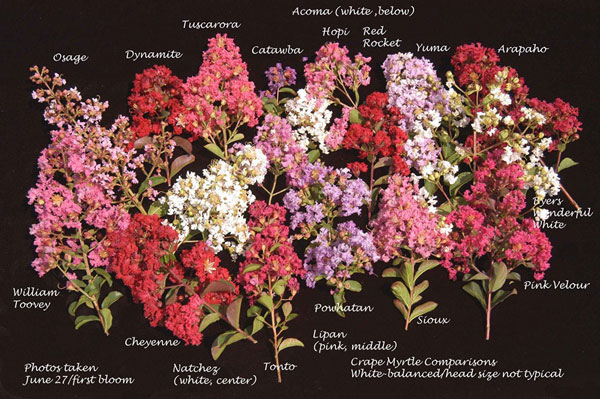Best Crape Myrtles for Texas
You may recall that I did a talk a week ago in McKinney on the topic of crape myrtles. I invited you to attend, but I didn’t give you much information about choosing the best types for Texas landscaping.

As we have been developing the Crape Myrtle Trails of McKinney over the past 20 years we have paid close attention to which types have performed best under a variety of conditions (cold, heat, drought, pest onslaughts and so on), and I thought it might be of interest to you to see the ones that have scored at the top. We also have enlisted the help of several national authorities on crape myrtles as well, and these are the ones we would now suggest. This is a revised list I showed in my talk.
Dwarf (3-5 ft.)
Red: Petite Red Imp, Petite Red Embers
Pink: Petite Pinkie, Pokemoke
Lavender: Petite Orchid
Purple: Petite Plum, Centennial, Velma’s Royal Delight
White: Petite Snow
Intermediate (5-10 ft.)
Red: Cheyenne, Tonto
Pink: Hopi, Pecos
Lavender:
Purple: Zuni
White: Acoma, White Chocolate
Medium (10-20 ft.)
Red: Centennial Spirit, Dynamite
Pink: Osage, Pink Velour, Seminole, Tuskegee
Lavender: Apalachee, Lipan, Yuma
Purple: Catawba, Powhatan
White:
Tall (in excess of 20 ft.)
Red: Arapaho, Red Rocket
Pink: Biloxi, Choctaw, Potomac
Lavender:
Purple: Twilight
White: Fantasy, Glendora White, Kiowa, Sarah’s Favorite White, Townhouse
Why are some common types missing?
You may have noticed the absence of several of the most common varieties from this list. Some of these are fast-growing types. Wholesalers like them because they can get them out of the nursery and into the hands of their retailers faster than they can with some of the ones we ranked more highly. But it’s our opinion that you ought to plant for long-term quality, not just for speed of growth.
We feel that the tall whites we listed are better (and more cold-hardy) than Natchez. Muskogee (tall light lavender) and Tuscarora (tall rosy red) are not as winter-hardy as we would like in North Central Texas, although they will do fine in South Texas.
Sioux is a fabulous pink, but it’s also tender to North Texas winters, as is the beautiful Country Red.
I would advise that you shop for your crape myrtles now, while nurseries still have their best selections. Buy a type that meets your space availabilities. Plant in full sun for best bloom. Transport your plants home carefully, either wrapped to protect them from highway winds or inside a closed trailer or truck. Plant them right away, and keep them damp at all times. Water deeply every two or three days until late fall.
